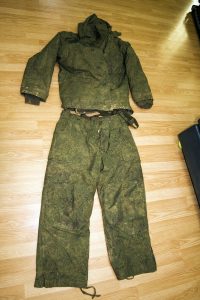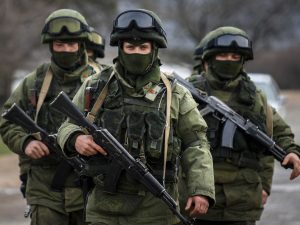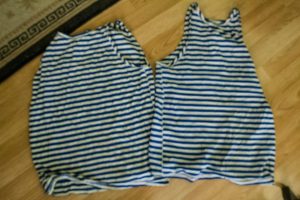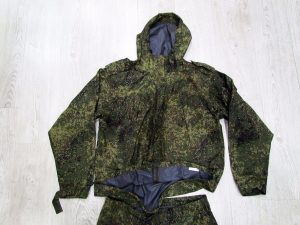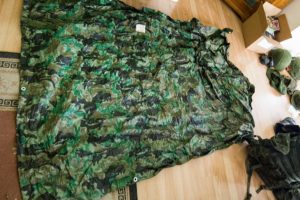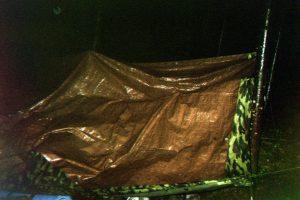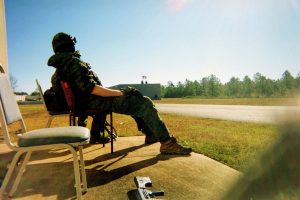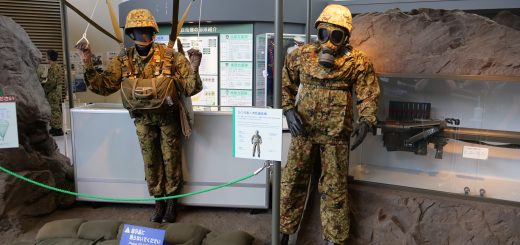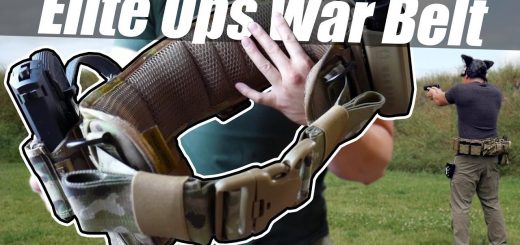The Key to Staying Warm and Dry at Milsim or General Camping/Hunting in Adverse Conditions.
Almost every event I have been to, I have been subject to the complaints of the people around me. Everything from getting wet, soaked, cold, frozen, can’t sleep because of cold, dampness, or discomfort.
I recall back to the first Nuggetfest I attended, Winter of 2015.
Saturday brought snow, then freezing rain, hail and sleet. Everyone wanted to leave Saturday evening but could not. The campsite was accessible only by 4-wheel drive vehicles, who got stuck attempting to leave late Saturday afternoon. This meant everyone had to stay one more day. massive fires were built, and attempts to keep them going all night despite the freezing rain just to keep people from freezing to death.
Most people’s tents had been frozen, then thawed, then soaked on the inside, as well as their sleeping bags or systems. I came to the event with 5 others, and even the most prepared boy-scout ended up getting all his gear soaked and ended up freezing cold and sleeping in another tent.
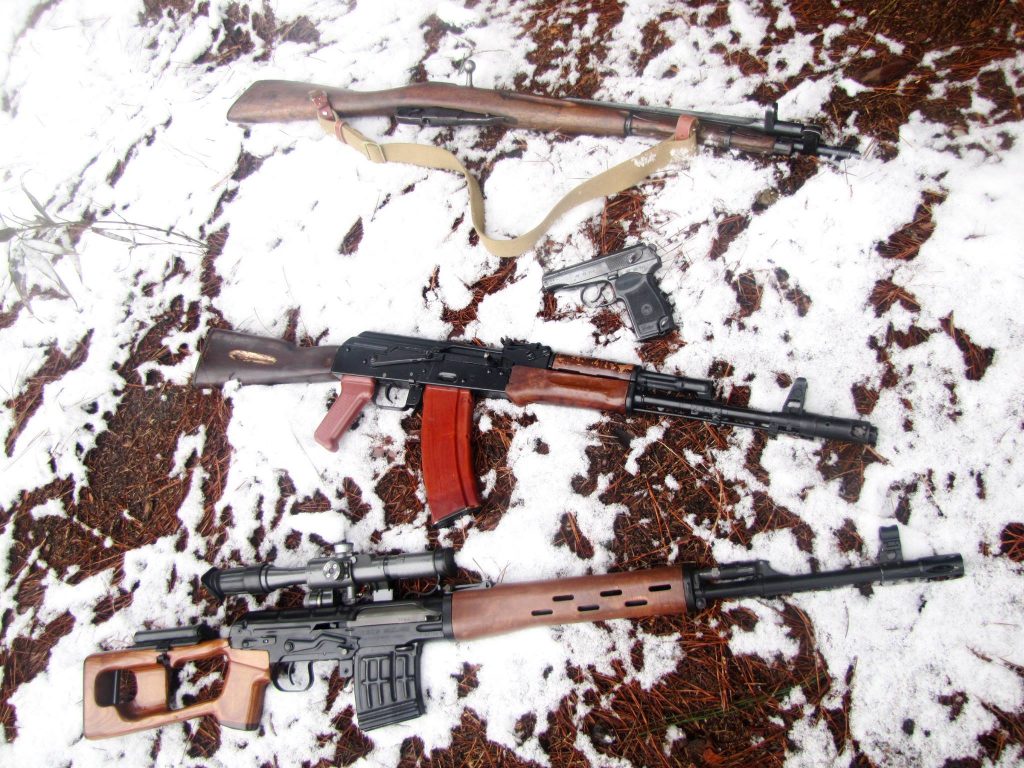 Sunday morning, two of my friends, both brothers, told me they could not feel their feet. Their feet and stocks had gotten damp, froze over, and felt so cold that one of the brothers even said he was afraid his toes needed amputation. I knew that was an exaggeration, there was no way it got cold enough for frostbite to set in, but the discomfort he felt was enough for him to complain in such a way. On the other hand, My feet never felt the chill of night, and I slept comfortably without waking up once all night long.
Sunday morning, two of my friends, both brothers, told me they could not feel their feet. Their feet and stocks had gotten damp, froze over, and felt so cold that one of the brothers even said he was afraid his toes needed amputation. I knew that was an exaggeration, there was no way it got cold enough for frostbite to set in, but the discomfort he felt was enough for him to complain in such a way. On the other hand, My feet never felt the chill of night, and I slept comfortably without waking up once all night long.
That event, I was the only one among my group, and I might have been the only one at the event, who stayed dry and warm the entire time. I knew it was going to be freezing and wet based on the weekend’s weather reports, and I was looking forward to it. I was looking forward to testing all my gear and seeing how well it worked in adverse conditions. I had used my gear before in week long hunting trips, but down here in Georgia, “Cold” means a different thing, as it rarely gets below freezing, especially not in the fall.
After that Nuggetfest, I felt confident that I could stay warm and dry and at any event I went to, and I would bring my cold weather gear everywhere I went. From /k/ meets, to milsim events, I was always warm and dry, even when we had weather where it would rain all weekend.
The key to my success relies on a few essential items.
The first, and most important in my opinion, is the Russian BTK Winter uniform. This uniform is designed for winter use, but even in the summer I’ll bring it to events. You never know how cold it can get at night.
At the last Milsim West game, Balkar Ridge, even though it was May in Virginia, the rain all Friday evening and night caused temperatures to drop into the high 30s. There was a large participant dropout due to individuals who were ill prepared.
Being able to wear the winter uniform while on night watch and patrols kept me warm and dry. The Uniform is relatively waterproof, but not completely. In heavy rain for very long periods of time, eventually the water can start penetrating the outer shell, but such occurrences are rare and I usually do not need to worry about that happening. Waxing it can be a good idea if you know it will be heavy raining all night and you will be out on long night patrols, but I doubt such a scenario will happen, as typically, if you are on watch, you will take some other form of shelter in such weather conditions.
I will even use the BTK uniform as a sleeping system during warmer events. In Milsim West, this can be very effective as you can get up immediately and start fighting in the case of an enemy night raid. At The Caspian Gap, my squad was positioned on the roofs, where we would give support fire and keep watch. When nightfall came and the temperature started to drop, we would rotate watch. As it was still fairly warm, my uniform worked perfectly as a wearable sleeping bag. I was able to lay down on my sleeping mat, break the wind with a bivy cover, sleep, and then when I was up for night watch, I could just get right up and watch for enemy movement. Or when I was sleeping, and the enemy raided our position during the night, I was able to get right up and instantly begin fighting.
Not to mention, the BTK Winter EMR uniform is a must for that Russian Occupation of Crimea aesthetic.
The BTK uniform is designed for winter use, and because of this it can get too warm very fast if you are moving around and the weather is merely just chilly. This can cause you to begin to sweat, and the last thing you want to do is get the inside of your uniform wet and then have your one hope for staying warm ruined by moisture. So think smart. If you are going to be marching out with a squad and attacking NATO in the dead of night, it might not be the best idea to bring your winter uniform on that operation. Even if it’s cold, running around shooting bbs or blanks at NATO or rucking a couple klicks to a new location, the energy you expend will generate a lot of heat, and that winter uniform can quickly overheat you. Your standard uniform is probably best for this operation.
I personally sweat a lot on my back and chest area, so I keep a few spare undershirts readily available. It’s always a good idea, especially if camping or at a milsim event, to keep all your spare stuff sealed up in plastic bags to keep them dry. Push out as much air as you can to keep from any kind of condensation forming and getting things damp from the inside.
Usually after a long ruck, my undershirt will be completely soaked, even if it is cold. Rucking 70+lb of gear a couple klicks will really give you a workout. When I arrive at my new location, I’ll change shirts and hang the wet one up to dry. Usually by the time I soak my second one, my first shirt is already dry. Although I always bring a third just in case. When I arrive to an event, I am wearing one and have two packed in my ruck.
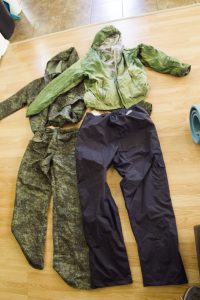
On the left, crappy $20 commercial EMR “waterproof” uniform. On the right, actually waterproof commercial nylon rain-suit
Keeping dry on the outside isn’t really a hard thing to accomplish. You just need to be smart about when and how you put on or use your gear.
If you look on ebay, you’ll see these $20 “waterproof” EMR commercial uniforms for sale from Russia. I made the mistake of buying a set and let me tell you, they aren’t really waterproof. On the other hand, a $20 Coleman nylon rain suit from Wal-Mart is all you need to keep the water off yourself.
There are actual military VKBO waterproof layer 6 outer shells that do work as effective rain suits, but they are expensive at around $120. I am planning on getting one soon to add to my gear collection.
At Balkar Ridge, It started raining late Friday afternoon and rained all night long. We had to ruck through the rain and set up camp in the rain. I brought along a commercial nylon rain suit and put that on before the event, then put the “waterproof” EMR rain suit just so I at least looked correct with the rest of my faction. The water ended up penetrating through that EMR rain suit, but my commercial suit kept the water from getting inside. The only issue was that it kept a layer of water between the EMR rain suit and the commercial rain suit, so once I got to the campsite I took the EMR rain suit off and just set up camp wearing the farb, but effective, commercial suit. Everyone else wore their 6sh122 ratnik suits, which all got soaked, and they ended up having to switch to secondary uniforms they brought. We wanted to remain uniform, as we were doing 45th VDV impressions, but in the end we ended up looking like some militia group, with a mixture of EMR, gorkas, and mountain flora uniforms. The next day when the rain finally lifted, I was the only one wearing the 122 ratnik suit as everyone else’s were still completely soaked, and since it was cloudy, the uniforms didn’t dry till the end of the day.
Now, to keep dry during the night, a shelter is what is going to keep you dry and protected from the winds, rain, and water. Typically if you are camping, just get a good commercial waterproof tent. Set up up well with tarp ground cover, and make sure it’s sealed so no water gets into your tent at night. I swear every Nuggetfest and overnight /k/ meet I have gone to, with the exception of the Alabama meet, it has rained during the night, and every time I see people come out of their tents in the morning wet and their sleeping bags soaked. Invest in a good tent, and set it up in terrain that won’t let water pool into the tent location.
Now if you are at a milsim event, you’ll be building your own shelter with the use of a tarp. At Balkar Ridge, we rucked into our location a little later than planned, and then spent too much time digging foxholes, which turned out disastrously for some people. By the time we set up the tarps it was already dark, and we had to set everything up in the dark.
The plan was to set the tarps low to the ground while we peaked through a small opening from within the foxhole, so we were more inconspicuous. However, the fox holes let water pool into them and would soak sleeping bags and gear. The next day we build a much better shelter during the daylight, with much more consideration in location and where water might pool.
Setting up your shelter in a location that will not let water pool into it is an important thing. Try and get it up while you have light, and consider your terrain, where water will flow off your tarp, and if any water will flow into your shelter.
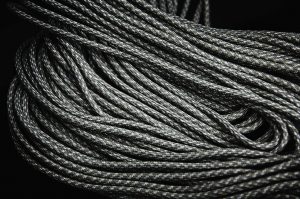 Also, you can never have enough paracord. You just never know how far between trees you might need to tie up your tarp, and you want to try and get the tarp stretched out and tight so water doesn’t pool on top of the tarp.
Also, you can never have enough paracord. You just never know how far between trees you might need to tie up your tarp, and you want to try and get the tarp stretched out and tight so water doesn’t pool on top of the tarp.
Now, despite the bad shelter we had the first night, I was still able to keep dry and warm, despite water pooling into the foxhole. We had put a tarp underneath us, and on top of that tarp I put a sleeping mat.
 The sleeping mat is one of the most important things to bring to keep warm when sleeping, as it keeps you insulated from the ground. The ground will act as a heat sink, and suck up the heat right out of your body into its bottomless pit of cold earth. Your mat is the insulation that will separate you from that heat sucking pit of despair.
The sleeping mat is one of the most important things to bring to keep warm when sleeping, as it keeps you insulated from the ground. The ground will act as a heat sink, and suck up the heat right out of your body into its bottomless pit of cold earth. Your mat is the insulation that will separate you from that heat sucking pit of despair.
By setting my mat out, and then rolled at the end near where the water was trickling into the shelter, the water flowed away from me and to the sides, instead pooling into the tarp, and under my mat.
So while the mat helped keep the water away from me, what really saved my ass was my sleeping system.
The USGI 4 piece “Military Modular Sleep System” (MMSS) is the best sleeping bag you will ever buy. The sleeping system consists of 4 peices.
The compression sack, designed to contain the whole system into a compressed space
The Bivy cover, which is a weatherproof, waterpoof, windproof cover that keeps outside elements out of your bag.
The Patrol Sleeping Bag, rated for weather 30° to 50°F, which is a nice lightweight sleeping bag that is easy to carry around.
The Intermediate Cold Weather Bag, rated for 30° to -10°F. This bag takes up the most space of the 4 components, taking up as much space as the Patrol bag and Bivy cover combined, however, it is indispensable when the weather gets below freezing.
When you combine the patrol bag with the cold weather bag, together they are rated for -30°F.
Now, while the bags are rated for these weather conditions, you won’t necessarily be comfortable in the lowest temperature they are rated for. So while the Patrol sleeping bag is rated for 30 degrees, personally I would be using the cold weather sleeping bag in that weather. Hell if I really just want to be toasty, if it’s below freezing and especially if there is freezing rain and ice outside, I combine both bags together.
In practical application, if I know it’s going to be dropping below freezing, and I can expect temperatures to hit 30 or below, I bring both sleeping bags and I use both sleeping bags. The temperatures reported by your weather channel aren’t always the same as the felt temperatures. Different conditions can affect how you feel in the same temperature.
When using the sleeping bags in cold weather, it is best to strip down into minimalist clothing. Your core, the chest, is what will keep your body warm. Once sealed in your sleeping bag your bodily heat will begin to circulate through the bag and keep other body parts warm.
To top off the experience, use the weatherproof bivy to keep the outside elements out. By zipping yourself up in that outer shell, it insulates you from the outside cold, breaks any wind that could beat against your sleeping bags, and keeps moisture out.
During the Caspian Gap, we slept on the roof tops, and at 2-3 stories high, the wind could really drop the felt temperature and beat through bags. Using the bivy to break the wind kept me feeling warm at night. Then in the morning, most of my squad was complaining that they had frozen feet. What had happened was dew set in, and it dampened their bags, the winds dropped the temperatures and their bags frosted over, in particular near their feet for some reason. I had slept with thick wool socks, and the dew and frost stayed on the outside of my bivy, so none of it ever touched my sleeping bags. One more thing that kept me dry and warm that event.
Then again at Balkar Ridge. Even when water trickled into my sleeping mat, encased within my bivy, I was able to keep dry and warm. The same couldn’t be said about the rest of my squad, who’s sleeping bags had become soaked from the water seeping into our shelter, leaving them damp, cold, and miserable Friday night.
If it’s not going to get too cold at night, I’ll typically just wear my BTK winter suit and then use one of my sleeping bags like a blanket, and then use my bivy to protect myself from the elements. This works pretty well at Milsim West events as I can keep warm, dry, and still be able to quickly respond if there is an attack on our position.
The MMSS is a mummy style sleeping bag, you can zip yourself up all the way over if you want to, although I like to breathe so I will typically have only my face out if it is cold. Over my face, I wear the VKBO balaclava. In my opinion, this is the warmest and most comfortable balaclava on the market. Superb quality, easy to breathe through, but thick enough to keep your face warm. When it is cold, I will wear this over my face and during the night, the balaclava will warm the air as it enters through my nose or mouth, preventing my lungs from becoming cold. I bring it to every event not only because it is Gucci, especially when running green beans, but I have become addicted to wearing it during the night due to the fact that it keeps my head warm and comfy.

packing your spares into plastic baggies keeps water and moisture out, ensuring dry stocks when you need them.
The next thing, thick wool socks. Nothing keeps your feet warmer than a pair of wool socks. They can be a real life saver when at an event. If your feet are warm, I can guarantee you will be a happy individual. I always bring a few pairs of socks just in case and package them into plastic baggies to keep water and moisture out. Dry socks are amazing when you are getting ready to pass out for the night. For whatever reason, my feet do not sweat, so usually I can wear a single pair of socks through an entire event without having to change, however, if you are like most people, bring a few pairs of socks. If you sweat out a pair and they become damp, there is nothing like drying your feet and putting on a pair of dry socks.
 Leading out of that point, to keep your socks dry, good boots are a must. The last thing you want to do is have boots that let moisture and water in. Once the water is in, no matter how many socks you put on, they’ll just become wet again in your boots. I personally wear the Russian issued Faradei Mod boots. There are different Models, and I have found them to be excellent boots. At milsim events, I typically find myself even sleeping with them on, even in my sleeping bag as it is more convenient to be able to jump out at any moment and have my boots already on. I have never had water penetrate or seep into my boots. At Balkar Ridge, the rest of my squad all had damp feet, and their boots had allowed water into them. At that event, I was the only one who had warm and dry feet to the point where I didn’t even change my socks once. Quality waterproof and water tight boots are an absolute must in my experience.
Leading out of that point, to keep your socks dry, good boots are a must. The last thing you want to do is have boots that let moisture and water in. Once the water is in, no matter how many socks you put on, they’ll just become wet again in your boots. I personally wear the Russian issued Faradei Mod boots. There are different Models, and I have found them to be excellent boots. At milsim events, I typically find myself even sleeping with them on, even in my sleeping bag as it is more convenient to be able to jump out at any moment and have my boots already on. I have never had water penetrate or seep into my boots. At Balkar Ridge, the rest of my squad all had damp feet, and their boots had allowed water into them. At that event, I was the only one who had warm and dry feet to the point where I didn’t even change my socks once. Quality waterproof and water tight boots are an absolute must in my experience.
 On top of spare underwear and undershirts, the final items I have to add to this list are a good pair of knuckle reinforced gloves, knee pads and elbow pads. I personally use SPLAV “Rage” gloves and SPLAV X-forme pads. The reason I add these to the list is purely due to falling, crawling, or for sitting positions. When it is damp outside, and the ground has become soaked in with water, when crawling into your shelter, you tend to put a lot of pressure at the joints, in particular the knees and elbows. Putting this pressure on can push the water and moisture out of the ground and directly into your clothing, causing your elbow and knee areas to become damp and cold. Wearing knee and elbow pads help prevent this from ever happening. If it is damp outside, and you wish to rest, it can be very convenient to get into a kneeling position and then rest against a tree or sit down with your knees to the ground. It keeps the moisture from getting into your uniform or clothing you might be wearing, and helps in a variety of positions such as the kneeling shooting position.
On top of spare underwear and undershirts, the final items I have to add to this list are a good pair of knuckle reinforced gloves, knee pads and elbow pads. I personally use SPLAV “Rage” gloves and SPLAV X-forme pads. The reason I add these to the list is purely due to falling, crawling, or for sitting positions. When it is damp outside, and the ground has become soaked in with water, when crawling into your shelter, you tend to put a lot of pressure at the joints, in particular the knees and elbows. Putting this pressure on can push the water and moisture out of the ground and directly into your clothing, causing your elbow and knee areas to become damp and cold. Wearing knee and elbow pads help prevent this from ever happening. If it is damp outside, and you wish to rest, it can be very convenient to get into a kneeling position and then rest against a tree or sit down with your knees to the ground. It keeps the moisture from getting into your uniform or clothing you might be wearing, and helps in a variety of positions such as the kneeling shooting position.
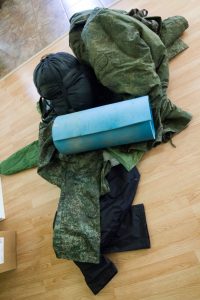 With that completes this write-up on gear I use to keep warm and dry during events. I hope that you all are able to take this advice and stay prepared for the worst at the events you attend, making you the envy of the group.
With that completes this write-up on gear I use to keep warm and dry during events. I hope that you all are able to take this advice and stay prepared for the worst at the events you attend, making you the envy of the group.
Stay tuned as my next article I will be detailing gear I use at Milsim West events, and how I pack my ruck. I will detail how I stay prepared, and how I pack the items i need to remain warm, dry, and happy during Milsim West games.

